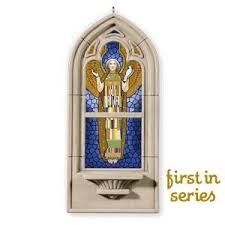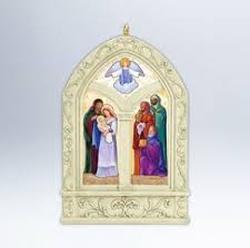Windows of Faith series
This ornament series features a stained glass window showcasing an element of the faith. Stained glass windows have long been used to explain aspects of the Gospel or Old Testament. They have traditionally served two purposes. First, they are to educate. They are like medieval photographs of a Biblical scene, presented to an audience that often could not read, in order to teach the Bible stories from one generation to the next. Secondly, they are to uplift and inspire. It is not enough to merely admire whatever story is being presented in a stained glass window. The viewer was called to go beyond that, to incorporate the window, as it were, into himself, by lifting his thoughts, prayers and hearts heavenward. The vibrant colors of the window, the interesting and important subject matter, encased within a place of worship, were all designed to be calls to the viewer effectively saying "Come in! Look deeper! Climb higher!" The more modern stained glass windows of today still serve this same purpose, with the additional feature that they also try to incorporate an emotion, like the stained glass windows above.
Fr. Ron Rolheiser, OMI, often comments that one of the most basic elements of light is how we interact with it. We never actually see the light (think about staring straight into the sun for a few seconds). Rather, we see BY, THROUGH and BECAUSE of the light. Without the presence of the light we are, quite literally, blind. The simple fact is that we are made for the light, and we must have it to survive. Christians call Jesus this very light, the light of the world, meaning that not only does the light of his person illuminate our everyday work world, but that his light also enters our hearts and minds, enabling us to understand, for example, the depth of meaning conveyed in a stained glass window.
This ornament series visually represents the best of the stained glass window tradition. Each ornament can be plugged into the light strand on your Christmas tree. Without the light plugged in, the ornament still conveys meaning, but with the light it becomes translucent, a fitting reminder of the Light born at Christmas.
Fr. Ron Rolheiser, OMI, often comments that one of the most basic elements of light is how we interact with it. We never actually see the light (think about staring straight into the sun for a few seconds). Rather, we see BY, THROUGH and BECAUSE of the light. Without the presence of the light we are, quite literally, blind. The simple fact is that we are made for the light, and we must have it to survive. Christians call Jesus this very light, the light of the world, meaning that not only does the light of his person illuminate our everyday work world, but that his light also enters our hearts and minds, enabling us to understand, for example, the depth of meaning conveyed in a stained glass window.
This ornament series visually represents the best of the stained glass window tradition. Each ornament can be plugged into the light strand on your Christmas tree. Without the light plugged in, the ornament still conveys meaning, but with the light it becomes translucent, a fitting reminder of the Light born at Christmas.
Glad Tidings
In that region there were shepherds living in the fields, keeping watch over their flock by night. Then an angel of the Lord stood before them, and the glory of the Lord shone around them, and they were terrified. But the angel said to them, "Do not be afraid; for see — I am bringing you good news of great joy for all the people: to you is born this day in the city of David a Savior, who is the Messiah, the Lord. (Luke 2:8-11)
Ornament details:
In Biblical symbolism, the color gold always represents glory, specifically the glory of God. Her golden cloak, wrapped around her, is also an image meant to express that she is a traveler, but also a person of authority. Persons of high rank and nobility are often draped with an expensive robe that sets them apart from everyone else, while at the same time conveying a position of authority. The golden cloak also has stars on it, linking her message to another famous cloak, that worn by Mary at Guadalupe. In both cases, the stars signify a universal message of salvation, one that starts locally but is intended for the entire world. The angel's position of arms raised and stretched upwards is a classical position of prayer and worship. A person in this position has a specific name, the orans, Latin for "the pray-er", one who prays. This is a very old image, even being seen in the burial chambers of the early Christians, for example. Mary is frequently portrayed in this position, and we make this request of her in many prayers when we say Ora pro nobis, Latin for "Pray for us." An especially interesting element of this ornament is the angel's dress. It is broken into several different vertical slabs of color, unlike the traditional dress of angels (typically a long solid color, with few decorative elements.) This angel, however, is more modern. Her dress images the stained glass windows of today, which are not just meant to express a scene in a Biblical or saint's story, but also frequently try to express an emotion or an abstract concept. Her dress is reminiscent of the famous painting by Gustav Klimt "The Kiss." In that modern painting, the robe of the man kissing the woman is also broken into slabs of color, mostly gold and black. What an appropriate image to recall for Christmas, as well, the intersection of the divine with creation, the kiss of God to his people, resulting in new life! (See the painting HERE.) The last detail to ponder is the dove resting in the left hand of the angel. In traditional religious art, it is usually the right hand of Jesus that blesses. The left hand is reserved for judgement. Since Christmas is such a happy occasion, why isn't the dove, traditionally a symbol of the Holy Spirit, in the right hand, signifying a great blessing? The answer is that the Incarnation, the Christmas event, does in fact signify a judgement. In the book of Hosea, after seeing how far his people are from him, God contemplates sending a severe punishment, saying "The sword shall rage against their cities, consume the bars of their gates and devour them in their fortresses. (v.6)" Yet, reading further, there comes a change. Thinking about his people once more, God cries "How can I give you up, O Ephraim! How can I hand you over, O Israel! . . . My heart recoils within me, my compassion grows warm and tender. I will not execute my fierce anger. . .for I am God and not man, the Holy One in your midst, and I will not come to destroy (v.8)" In his book Behold the Pierced One, Pope Benedict quotes another author , H. Gross, in saying that the "upheaval occasioned in God's heart by the divine love has the effect of quashing his judicial sentence against Israel; God's merciful love conquers his untouchable righteousness." God chooses mercy over justice in the Old Testament, and he does it again in the New Testament. Because of this, in the fullness of time, an angel was sent to a virgin, who was overshadowed by the Holy Spirit so that nine months later an angel appeared to some shepherds tending their flocks, bringing glad tidings. ""Do not be afraid; for see — I am bringing you good news of great joy for all the people: to you is born this day in the city of David a Savior, who is the Messiah, the Lord." |
Peace On Earth
Ornament details:
|

